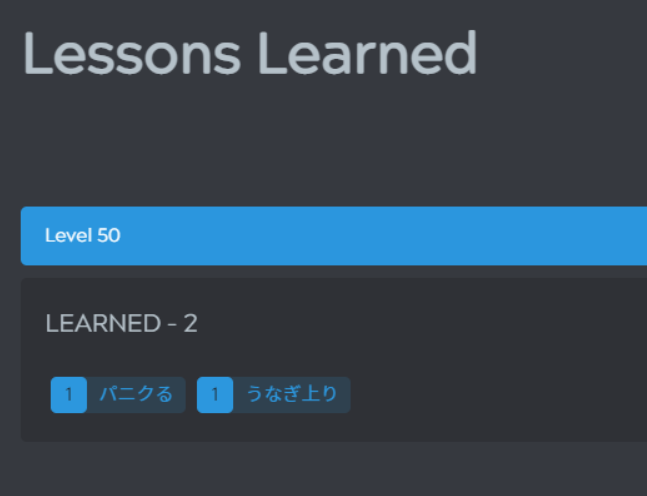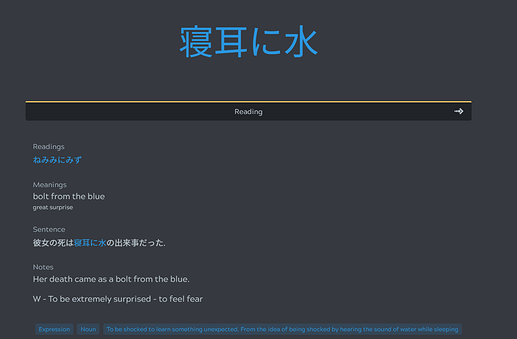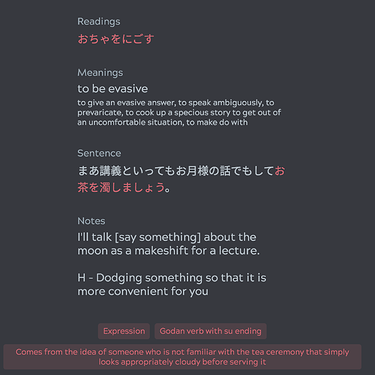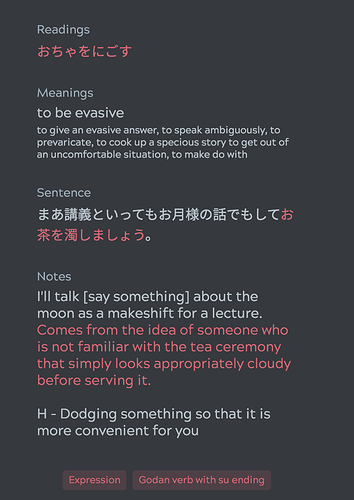Hey yeah no problem! I’m actually going to try to bring out that deletion request system (mentioned elsewhere) with the next update (hopefully this weekend  ) Would it be OK to wait until then? Seems like a nice “live” test as well
) Would it be OK to wait until then? Seems like a nice “live” test as well 
Sounds great, didn’t know that was a coming feature!
Guess who’s on board to learn this deck 



Suggestions to improve the deck are always welcomed!
At least one of those lesson entries must be a premonition. 
- パニクる
- うなぎのぼり
0 voters
I’m still crawling through so I guess I’m still パニクる mode 
Can I ask why do you have these explanatory texts in tags and not on notes? 
To be shocked to learn something unexpected. From the idea of being shocked by hearing the sound of water while sleeping
The idea was to keep the Sentences/translations more readable w/ special notes as parts of speech. If you prefer it in notes, I can change it. There are ~12 cards that do this.
This deck sort of ‘evolved’ so when I started adding sentences, some idioms needed extra explanations.
Couldn’t you technically put the ENG sentence right at the bottom of the JP one (in the same field)?  That would allow the note field to be better organized, even with these descriptions.
That would allow the note field to be better organized, even with these descriptions.
If needed, I can send suggestions so that your workload is reduced. Just curious if there was any reason for separating the JP sentence from the ENG one.
I misspoke earlier, these notes are in the ‘frequency’ field (not parts of speech) so they will never appear in ‘front’ card.
The ‘sentence’ field doesn’t have a break, that would be my only issue. I’ve found myself reading the sentences more often, while the field note is more like ‘oh, that is nice to know’ but I don’t reference it all the time. So for users that want to test their reading and check comprehension, the field may be too cluttered otherwise…but that’s just my opinion.
I don’t mind making changes since it’s only 12 cards but I see a fair amount users sharing the deck now, so I’ll let others weigh in if they would like the change or keep as is.
I’ve been using <br> for that in some of my personal notes, it’s breaking the answer fields but I think it’s okay enough for the notes 
Ok, I tried it and looks better and can highlight to separate it further. @jprspereira and everyone else, which is preferred?
Original
Break within notes
I like the new one more! Maybe giving a proper paragraph between the ENG translation and the expression’s explanation would be even better?  Just like you have between “serving it” and “H - Dodging something so that…”.
Just like you have between “serving it” and “H - Dodging something so that…”.
Those cards should be updated now. Just for reference, I’m using <p> to create the break and paragraph…didn’t know we could that within a single value, I like it better now so nice suggestions everyone. 
Looking solid! Appreciate the quick improvements 
It doesn’t necessarily bother me, but wouldn’t it be possible to have the ENG sentence in the “Sentence” field with the JP sentence, but the ENG one being blurred to avoid spoiling? 
You probably want something like the blur spoiler option in study session but for specific content in a field. I’m not sure how to set this up. 
You’d have to tag it with <p class='blur'>english sentence here</p> or something similar. the blur class should automatically blur it, and unblur it once you click on it. Note that this only works if the setting is turned on for the user in their deck settings.
One minor thing that I noticed is that cards like ネックになる, ドタキャン, ぞっと, etc have the reading layout activated, so it would be cool to have it turned off for hiragana/katakana words  @s1212z
@s1212z
Good suggestion 
All set, if I missed any just let me know, thx!
@jprspereira, I saw your feedback on 大きなくちをきく. I didn’t find a resource with a sentence and reliable translation which is the case for other missing sentences. Of course there is the book itself but I’ve refrained from posting their sentence material. If you have a sentence you know and would like to add, would be happy to include it which I could then reformat the card to include the sentence/translation and note explanation (otherwise I’ll keep as is). It is sort of a main phrase so maybe why I couldn’t find anything.
I do like the sentence examples in the book because they keep the sentences conversational with a person A + B banter and 2 per entry.
Note: added ‘Verbs often used after [大きな口] include [きく] and [叩く]’ into comment which is from the book.
This link has 2 you can use 
Also, it seems that this expression is written with 口 over くち everywhere  Is the book using hiragana for it?
Is the book using hiragana for it?



